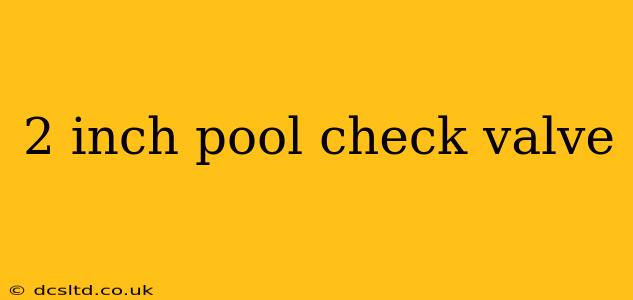Choosing the right check valve for your pool plumbing system is crucial for maintaining proper water flow and preventing backflow. A 2-inch pool check valve is a common size, but understanding its function and selecting the appropriate type is essential for ensuring efficient and reliable pool operation. This comprehensive guide will cover everything you need to know about 2-inch pool check valves, answering frequently asked questions and providing valuable insights.
What is a 2-Inch Pool Check Valve?
A check valve, also known as a non-return valve or one-way valve, is a crucial component in any plumbing system. Its primary function is to allow fluid to flow in only one direction, preventing backflow. In a pool setting, this prevents water from flowing back into the pump or other components when the pump shuts off, protecting equipment and maintaining system integrity. A 2-inch check valve specifically refers to the valve's nominal pipe size, indicating its internal diameter. This size is commonly used in pool plumbing systems for larger lines, such as those connected to the main pump or filter.
What are the Different Types of 2-Inch Pool Check Valves?
Several types of 2-inch check valves cater to various pool applications. The most common include:
-
Swing Check Valves: These valves utilize a hinged disc that swings open to allow flow in one direction and closes automatically to prevent backflow. They are relatively simple, inexpensive, and widely available.
-
Ball Check Valves: These valves employ a free-floating ball to seal against a valve seat, blocking backflow. They are compact and often preferred for their quick response and ability to handle higher pressures.
-
Foot Valves: These are specifically designed to be installed at the bottom of a suction line, preventing air from entering the pump when the pump is not running. They usually incorporate a check valve mechanism to prevent backflow.
How Do I Choose the Right 2-Inch Pool Check Valve?
Selecting the correct 2-inch check valve depends on several factors:
-
Flow Rate: Ensure the valve's flow capacity matches or exceeds your pool's pump flow rate to avoid restricting water flow.
-
Pressure Rating: The valve must withstand the pressure generated by your pool pump. Check the manufacturer's specifications to ensure compatibility.
-
Material: PVC is a common choice for its corrosion resistance and affordability. However, other materials like bronze or stainless steel might be suitable for specific applications.
-
Installation Location: Consider the accessibility and ease of installation when choosing the valve type and style.
Where Should I Install a 2-Inch Pool Check Valve?
Strategic placement of a check valve is crucial for its effectiveness. Common installation locations include:
-
On the suction side of the pump: This prevents water from draining back into the pool plumbing when the pump is off.
-
On the discharge side of the pump: This protects the pump from back pressure.
-
Before the filter: This helps maintain the filter's water level and prevents backflow into the filter.
How Do I Maintain a 2-Inch Pool Check Valve?
While generally low-maintenance, regular inspections are advisable to ensure proper operation. Look for any signs of leaks, corrosion, or damage. Periodically check for obstructions that might hinder the valve's operation.
What are the Signs of a Faulty 2-Inch Pool Check Valve?
A malfunctioning check valve can lead to several issues, including:
-
Reduced water flow: A partially obstructed or damaged valve can restrict water flow.
-
Pump cavitation: Backflow can cause air to be drawn into the pump, leading to cavitation and potential damage.
-
Loss of priming: If the valve fails to prevent backflow, the pump might lose its prime, requiring manual repriming.
What size pipe is a 2-inch check valve?
A 2-inch check valve is designed to fit a 2-inch diameter pipe. It's crucial to ensure compatibility to avoid leaks or restrictions.
Can I use a 2-inch check valve on a smaller pipe?
While technically possible with appropriate fittings, it's generally not recommended. Using a larger valve on a smaller pipe will introduce unnecessary bulk and could potentially restrict flow.
This guide provides a solid foundation for understanding and selecting the appropriate 2-inch pool check valve for your needs. Remember to consult with a qualified pool professional if you are unsure about any aspect of installation or maintenance. Properly functioning check valves are essential for maintaining the efficiency and longevity of your pool plumbing system.
